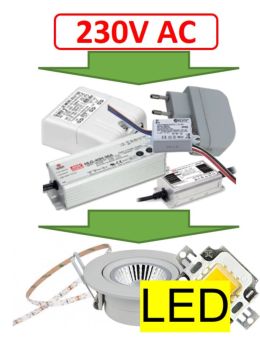What is the difference between an LED transformer and an LED driver?
LED transformers are specially designed for constant voltage operation of LED systems and supply a fixed voltage at the output, e.g. 12V or 24V.
A distinction is also made here between 12VAC (for e.g. 12V LED lamps, usually referred to as retrofit lamps) or 12V DC or 24V DC for operating mostly LED strips/LED tapes.
The voltage is constant (CV=constant voltage) and the current (mA) depends on the power of the connected lamps.
LED drivers, on the other hand, provide a constant current (e.g. 350mA). The reason for this is the special (U/I) characteristic curve of a diode, especially a light-emitting diode (LED). If operated with a constant voltage, the current would change considerably, even to the point of destruction, in the event of the slightest instability in the voltage or even ageing or temperature changes. For this reason, the current is limited or kept constant. An LED driver drives a constant current through the LED(or several LEDs connected in series). The voltage that then "drops" at the LED ("forward voltage") or the sum of these is then the voltage measured at the output of a driver. The power supply unit must be able to provide this. This is why voltage ranges are often specified here. The current is constant (CC=constant current) and the voltage depends on the characteristics of the LED system (number of LEDs).






